Originally designed by Goodwin Watson and Edward Glaser, The Watson-Glaser Critical Thinking Appraisal (Form AM) was a measurement of “how well you are able to reason analytically and logically.”
After their extensive use during World War One, experts increasingly used the tests as a tool to rank and filter individuals in contexts including (but not limited to) education and employment.
In this article, we’ll be providing you with an overview of The Watson-Glaser Critical Thinking Appraisal, its test format, and question examples for your practice.
Table of Contents
What is a Watson Glaser test?
The Watson Glaser Assessment (Watson Glaser Critical Thinking Appraisal) is designed by Pearson Talentlens – a part of the famous Pearson education publishing house. The assessment is a quick, consistent, and accurate measurement of the test-takers ability to analyze, reason, interpret and draw logical conclusions from written information.
This critical thinking test has five scales which are the elementary units of critical thinking and reasoning. These five units serve as parameters to measure all areas of critical thinking ability.
The test is administered to appraising adults (16 years and above) with questions of varying difficulty and format.
Watson Glaser Test format
The Watson Glaser Critical Thinking Appraisal is a timed test. It can be administered both online and offline, depending on the company you are applying to.
- For the online version (W-G III), the test is suitable for the unproctored screening of job applicants. Questions are selected randomly from a larger pool of questions called “item bank”. This helps minimize the possibility of cheating due to the fact that there are no applicants having the same set of questions.
- For the offline version (W-G II Forms D and E), applicants have to take the test under supervised conditions.
Upon finishing, applicants receive a percentile score with norm groups either provided by Pearson Talentlens or designed by the company.
Popular test formats are as follows:
- 40 questions – 30 minutes
- 80 questions – 60 minutes
The question distribution in a 40-question Watson Glaser test includes the following:
- Inference – 5 questions
- Recognition of assumptions – 12 questions
- Deduction – 5 questions
- Interpretation – 6 questions
- Evaluation – 12 questions
Watson Glaser test: 5 question types & examples
Five types of questions appearing in the test are
- Infer questions
- Recognize Assumption questions
- Deduce questions
- Interpret questions
- Evaluate Argument questions
/case_thumb/1672123157635_2022_watson_glaser_test.png)
Infer questions
You will find five choices of answers for each inference in the question: True, Probably True, Insufficient Data, Probably False, and False. Your job is to determine which choice best fits the hypothesis.
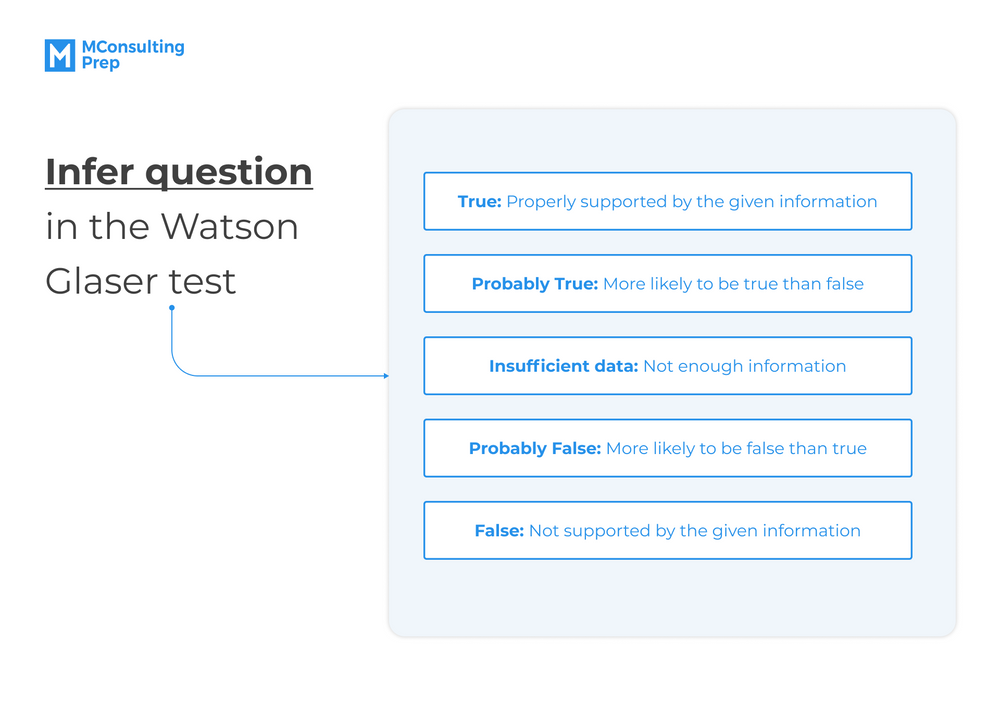
- True: If you think the inference is definitely TRUE; that it properly follows beyond a reasonable doubt from the statement of facts given.
- Probably True: If, in the light of the facts given, you think the inference is Probably True; that it is more likely to be true than false.
- Insufficient Data: If you decide that there are Insufficient Data; that you cannot tell from the facts given whether the inference is likely to be true or false; if the facts provide no basis for judging one way or another.
- Probably False: If, in the light of the facts given, you think the inference is Probably False; that it is more likely to be true than false.
- False: If you think the inference is definitely False; that it is wrong, either because it misinterprets the facts given, or because it contradicts the facts or necessary inferences from those facts.
Unlike popular aptitude tests where you use solely given information, this test allows the use of specific commonly accepted knowledge or information that practically every person has.
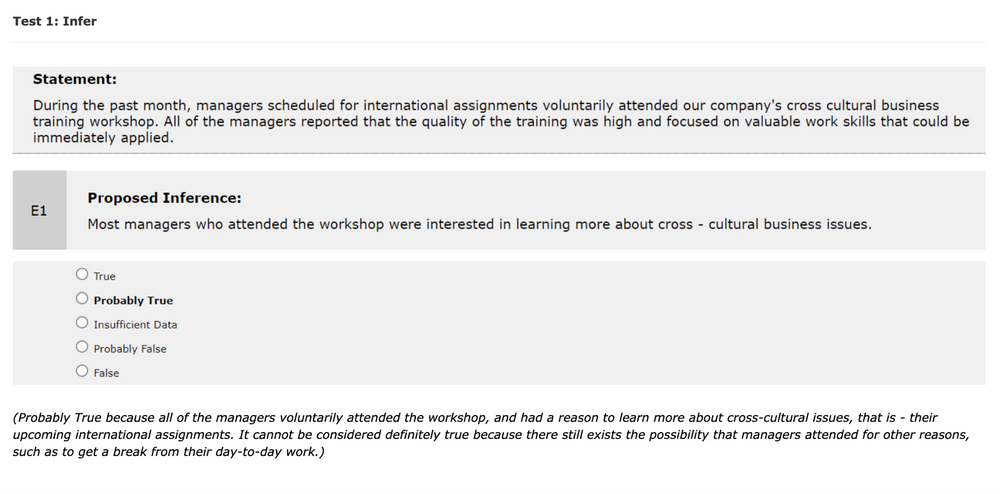
Source: Pearson Talentlens
Sample:
During the past month, managers scheduled for international assignments voluntarily attended our company’s cross-cultural business training workshop. All of the managers reported that the quality of the training was high and focused on valuable work skills that could be immediately applied.
The majority of training was devoted to rules and regulations for doing business in this country.
A. True
B. Probably True
C. Insufficient Data
D. Probably False
E. False
Answer: Probably False
Explanation: Probably False because the training focused on cross-cultural business. It cannot be considered definitely false because the specific course content is not provided.
Practice Example:
Chamonix is one of the oldest ski resorts in France. Last year, the Chamonix-Mont-Blanc Valley authorities introduced a climate and energy action plan, the first in the French Alps. The plan commits to reducing greenhouse gas emissions in the area by 22 percent. Among the proposed measures is a ban on the most polluting lorries using the nearby Mont Blanc tunnel. Climate change will have a major impact on the valley’s main economic activities: less snow on low-altitude ski slopes and the risk of increased pressure on high-altitude ski slopes have been recorded in recent studies. Natural habitats, river patterns, forests, and agriculture might be radically transformed, increasing the likelihood of hazards such as avalanches, floods, and landslides.
Although air quality is a great concern for those living at the foot of Mont Blanc, noise pollution is arguably the most noticeable at a local level.
A. True
B. ProbablyTrue
C. Insufficient Data
D. Probably False
E. False
Answer: Insufficient Data
Explanation: The passage does not mention noise pollution, as well as its existence at local level.
Recognize assumption questions
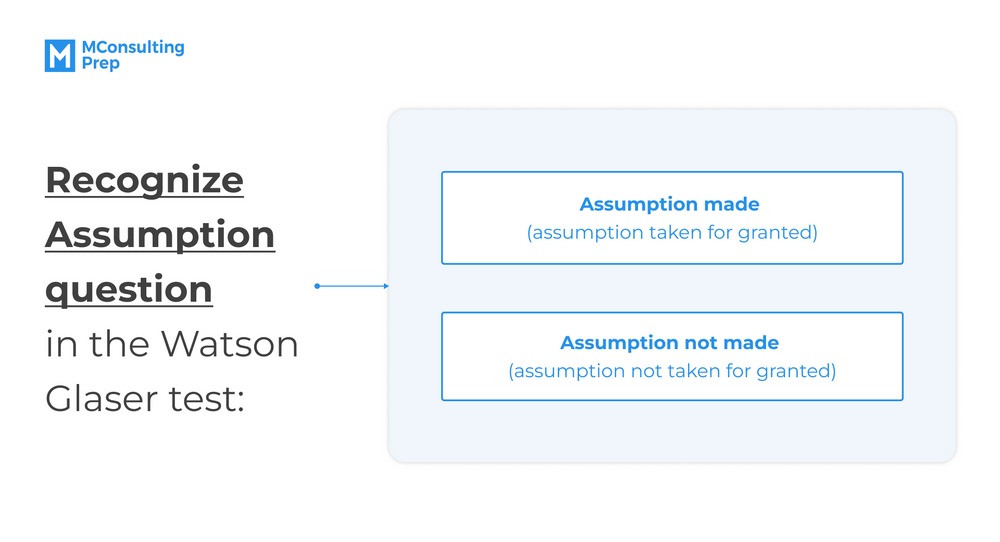
In this question, you are presented with a statement and two choices “Assumption made” or “Assumption not made“. Your job is to determine whether the statement is an assumption taken for granted (Assumption made) or an assumption not necessarily taken for granted (Assumption not made).
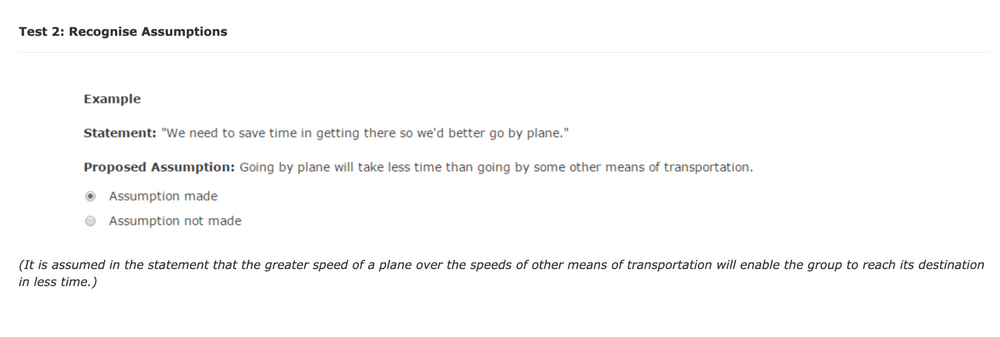
Source: Pearson Talentlens
Sample:
We need to save time in getting there so we’d better go by plane.
There is a plane service available to us for at least part of the distance to the destination.
A. Assumption made
B. Assumption not made
Answer: Assumption made
Explanation:
This is assumed in the statement because, in order to save time by plane, it must be possible to go by plane.
Practice Example:
While owning a pet can be expensive and is occasionally an inconvenience, it’s a good thing to do if you want to improve your chances of living a satisfying life.
Pet owners will always lead more satisfying lives than those who don’t own pets.
A. Assumption made
B. Assumption not made
Answer: Assumption not made
Explanation:
From the given premises, we can only see that: if you want a satisfying life, it is a good thing to have a pet. However, having a pet does not definitely lead to a satisfying life. There is no indication to compare the satisfaction between having a pet or not having a pet as a way to live a satisfying life.
Deduce questions
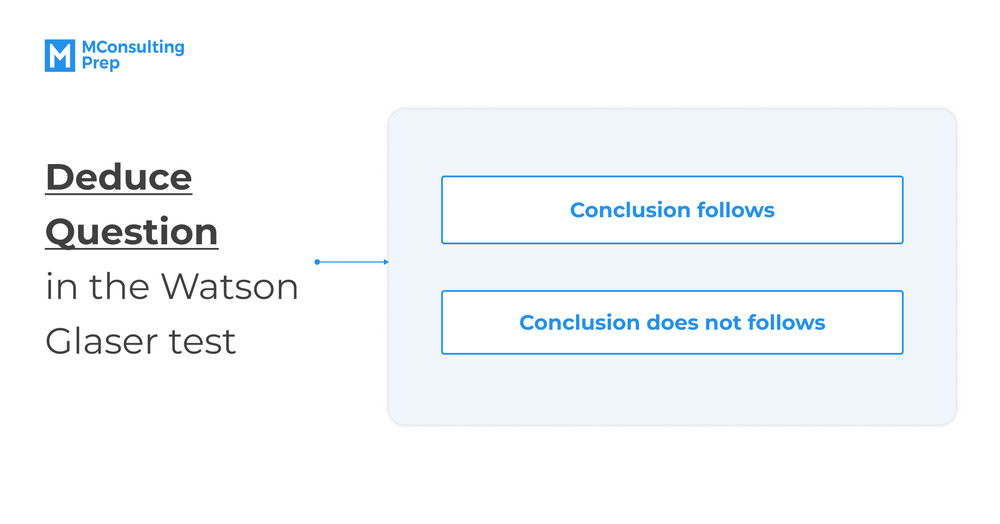
In this type of question, each item contains several statements (premises) followed by several suggested conclusions. For the purposes of the test, you must consider the given statements as true without exception. The question presents you with two options
- Conclusion follows: If you think the conclusion necessarily follows from the statements given;
- Conclusion does not follow: If you think it is not a necessary conclusion from the statements given.
Since the test requires you to regard given statements as completely true, you have to try not to let your common sense and existing knowledge interfere. You have to stick to only the given statements (premises) and make judgments as to whether it necessarily follows from the statement or not.
One thing to note is the use of the word “Some” in this type of question. It means an indefinite part or quantity of a class of things. It can be either a portion or perhaps all of the class.

Source: Pearson Talentlens
Sample:
Some Sundays are rainy. All rainy days are boring. Therefore …
Some Sundays are boring.
A. Conclusion follows
B. Conclusion does not follow
Answer: Conclusion follows
Explanation:
The conclusion necessarily follows from the statements because, according to them, rainy Sundays must be boring.
Practice Example:
Damage to roads in the area has made them unsuitable for loads over one ton. These loads are being transported to the capital by air, but as air resources are limited they are restricted to carrying food and medical supplies. Roads cannot be repaired until medical emergencies are dealt with. Therefore, …
Food can be taken to the capital by road.
A. Conclusion follows
B. Conclusion does not follow
Answer: Conclusion does not follow
Explanation:
Roads can not be used to transport food in loads over one ton. Food loads over one ton are being transported by air. We are not sure whether food in loads under one ton are delivered by road or anything else.
Interpret questions
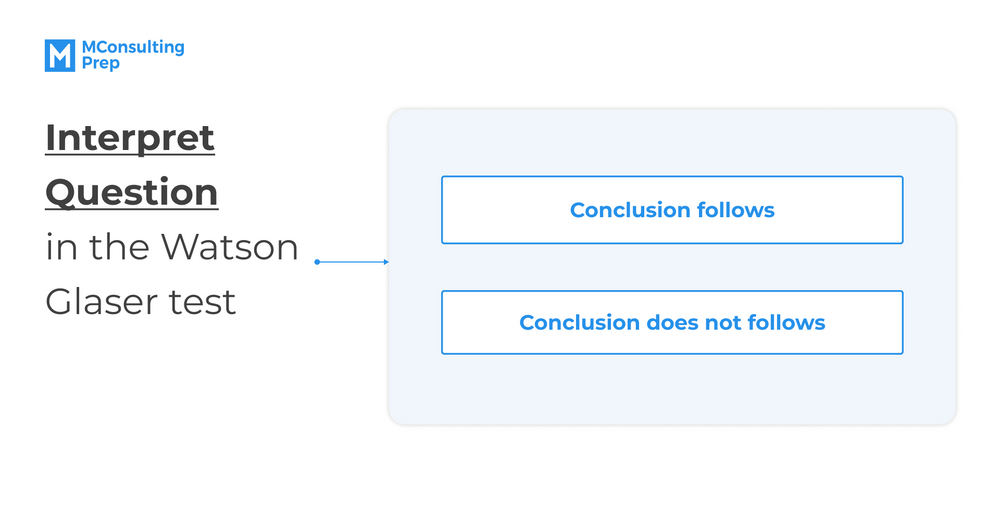
An interpret question provides you with a short paragraph followed by several suggested conclusions. You must assume that everything in the short paragraph is true, for the purpose of the test. To answer the question, you have to judge whether or not each of the suggested conclusions logically follows beyond a reasonable doubt from the information presented in the paragraph.
You have two answer choices:
- Conclusion follows: If you think the conclusions follow beyond a reasonable doubt (although they may not follow absolutely and necessarily);
- Conclusion does not follow: If you think the conclusions doesn’t follow beyond a reasonable doubt from the facts given in the short paragraph.
As a rule of thumb, you should judge each conclusion independently from your common sense or outside knowledge.

Source: Watson Glaser
Sample:
A study of vocabulary growth in children from ages eight months to six years old shows that the size of spoken vocabulary increases from zero words at age eight months to 2562 words at age six years.
Vocabulary is slowest during the period when children are learning to walk.
A. Conclusion follows
B. Conclusion does not follow
Answer: Conclusion does not follow.
Explanation:
The conclusion does not follow because there is no information given that relates the growth of vocabulary to walking.
Practice Example:
An accounting computer program, MagicNumber, is Wisdom Software’s biggest-selling product, with its development involving 20% of programmers and 30% of marketing staff. DesignAid, a graphic design program, is the latest offering from the company. It is definitely expected to sell more copies than MagicNumber and will have fewer programmers working on its design, but more marketing staff.
DesignAid will bring in greater profits for the company than MagicNumber.
A. Conclusion follows
B. Conclusion does not follow
Answer: Conclusion does not follow
Explanation:
The paragraph only mentioned that DesignAid is expected to sell more than MagicNumber. This does not necessarily mean that DesignAid uiwll bring greater profit than MagicNumber.
Evaluate argument questions

The question involves distinguishing between strong and weak arguments, as far as the question at issue is concerned. In each question, there is a series of arguments that you must regard as true. Your job is to determine whether or not each of these arguments is a strong or a weak one.
- Argument strong: If you think the argument is strong;
- Argument weak: If you think the argument is weak.
For an objective evaluation of the argument, you must judge each argument independently on its own merit, without the influence of your personal perception.
One thing to note is the use of the word Should. By using Should at the beginning of each question, it means “Would the proposed action promote the general welfare of the people in your country?”

Source: Watson Glaser
Sample:
Should young adults in this country go to university?
No; a large percentage of young adults do not have enough ability or interest to derive any benefit from university training.
A. Argument strong
B. Argument weak
Answer: Argument strong.
Explanation:
If this is true, as the directions require us to assume, it is a weighty argument against all young adults going to university.
Practice Example 5:
Is it worthwhile for a business to invest in training employees?
Yes, research shows the amount of money spent on training is positively related to profitability.
A. Argument Strong
B. Argument Weak
Answer: Argument Strong
Explanation:
The explanation show that business can increase their profit by invest more money on training. This is a direct back up evidence for the claim.
Which companies use Watson Glaser tests?
Watson Glaser Tests are popular in the pre-employment process across sectors such as medical, marketing, education, legal, and professional services. The test can be used for different job levels like Graduates, Execs and Managerial, Supervisors, and Professionals., depending on the company hiring request.
There are a great number of UK companies using it for their pre-employment screening process. The names include the following
- BCAT
- Linklaters
- Simmons & Simmons
- Hill Dickinson
- Hiscox
- Bank of England
- Burges Salmon
- Ince & Co
- Government Legal Service
- Irwin Mitchell
- Clifford Chance
- Deloitte
- Dentons
- Hogan Lovells
Prepare for aptitude tests with MConsultingPrep
Explore MConsultingPrep’s Aptitude Test – a strategic & comprehensive practicing platform with
- A question bank of +1000 aptitude questions (Numerical, Verbal & Logical)
- A comprehensive explanation of every question
- Evaluation and recording tools for performance reviews
You’ll be practicing more strategically with our test packages, to gain more confidence for every test question you might experience in your future aptitude tests.
Our massive question bank consists of a significant number of question variations from many test publishers and companies, across different companies & businesses.
With questions organized by type, you can leverage your preparation by
- Focusing on practicing questions in specific types
- Improving your performance in questions that you struggle with
With evaluation tools coming in handy, you have better insights into your overall performance, what you excel at, and what you need improvements on.
/filters:quality(75)//case_thumb/public/1699589977462_aptitude_tests_package_4_x.png)